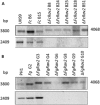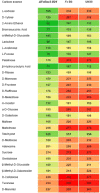FcRav2, a gene with a ROGDI domain involved in Fusarium head blight and crown rot on durum wheat caused by Fusarium culmorum
- PMID: 28322011
- PMCID: PMC6638036
- DOI: 10.1111/mpp.12551
FcRav2, a gene with a ROGDI domain involved in Fusarium head blight and crown rot on durum wheat caused by Fusarium culmorum
Abstract
Fusarium culmorum is a soil-borne fungal pathogen which causes foot and root rot and Fusarium head blight on small-grain cereals, in particular wheat and barley. It causes significant yield and quality losses and results in the contamination of kernels with type B trichothecene mycotoxins. Our knowledge of the pathogenicity factors of this fungus is still limited. A transposon tagging approach based on the mimp1/impala double-component system has allowed us to select a mutant altered in multiple metabolic and morphological processes, trichothecene production and virulence. The flanking regions of mimp1 were used to seek homologies in the F. culmorum genome, and revealed that mimp1 had reinserted within the last exon of a gene encoding a hypothetical protein of 318 amino acids which contains a ROGDI-like leucine zipper domain, supposedly playing a protein-protein interaction or regulatory role. By functional complementation and bioinformatic analysis, we characterized the gene as the yeast Rav2 homologue, confirming the high level of divergence in multicellular fungi. Deletion of FcRav2 or its orthologous gene in F. graminearum highlighted its ability to influence a number of functions, including virulence, trichothecene type B biosynthesis, resistance to azoles and resistance to osmotic and oxidative stress. Our results indicate that the FcRav2 protein (and possibly the RAVE complex as a whole) may become a suitable target for new antifungal drug development or the plant-mediated resistance response in filamentous fungi of agricultural interest.
Keywords: Fusarium graminearum; Fusarium head blight; fungal pathogens; fungicide; molecular target; transposon tagging; virulence genes.
© 2017 BSPP AND JOHN WILEY & SONS LTD.
Figures




Similar articles
-
Fusarium culmorum: causal agent of foot and root rot and head blight on wheat.Mol Plant Pathol. 2013 May;14(4):323-41. doi: 10.1111/mpp.12011. Epub 2012 Dec 28. Mol Plant Pathol. 2013. PMID: 23279114 Free PMC article. Review.
-
Transposition of the miniature inverted-repeat transposable element mimp1 in the wheat pathogen Fusarium culmorum.Mol Plant Pathol. 2012 Dec;13(9):1149-55. doi: 10.1111/j.1364-3703.2012.00823.x. Epub 2012 Aug 16. Mol Plant Pathol. 2012. PMID: 22897438 Free PMC article.
-
Fusarium crown rot caused by Fusarium pseudograminearum in cereal crops: recent progress and future prospects.Mol Plant Pathol. 2018 Jul;19(7):1547-1562. doi: 10.1111/mpp.12639. Epub 2018 Feb 9. Mol Plant Pathol. 2018. PMID: 29105256 Free PMC article.
-
The stress-activated protein kinase FgOS-2 is a key regulator in the life cycle of the cereal pathogen Fusarium graminearum.Mol Plant Microbe Interact. 2012 Sep;25(9):1142-56. doi: 10.1094/MPMI-02-12-0047-R. Mol Plant Microbe Interact. 2012. PMID: 22591226
-
Advances in Understanding Fusarium graminearum: Genes Involved in the Regulation of Sexual Development, Pathogenesis, and Deoxynivalenol Biosynthesis.Genes (Basel). 2024 Apr 9;15(4):475. doi: 10.3390/genes15040475. Genes (Basel). 2024. PMID: 38674409 Free PMC article. Review.
Cited by
-
In silico Prediction, Characterization, Molecular Docking, and Dynamic Studies on Fungal SDRs as Novel Targets for Searching Potential Fungicides Against Fusarium Wilt in Tomato.Front Pharmacol. 2018 Oct 22;9:1038. doi: 10.3389/fphar.2018.01038. eCollection 2018. Front Pharmacol. 2018. PMID: 30405403 Free PMC article.
-
Molecular Docking and Comparative Inhibitory Efficacy of Naturally Occurring Compounds on Vegetative Growth and Deoxynivalenol Biosynthesis in Fusarium culmorum.Toxins (Basel). 2021 Oct 26;13(11):759. doi: 10.3390/toxins13110759. Toxins (Basel). 2021. PMID: 34822543 Free PMC article.
-
Genome-wide association study for deoxynivalenol production and aggressiveness in wheat and rye head blight by resequencing 92 isolates of Fusarium culmorum.BMC Genomics. 2021 Aug 30;22(1):630. doi: 10.1186/s12864-021-07931-5. BMC Genomics. 2021. PMID: 34461830 Free PMC article.
-
Bioprospecting Phenols as Inhibitors of Trichothecene-Producing Fusarium: Sustainable Approaches to the Management of Wheat Pathogens.Toxins (Basel). 2022 Jan 20;14(2):72. doi: 10.3390/toxins14020072. Toxins (Basel). 2022. PMID: 35202101 Free PMC article. Review.
-
Selection of an Endophytic Streptomyces sp. Strain DEF09 From Wheat Roots as a Biocontrol Agent Against Fusarium graminearum.Front Microbiol. 2019 Oct 11;10:2356. doi: 10.3389/fmicb.2019.02356. eCollection 2019. Front Microbiol. 2019. PMID: 31681219 Free PMC article.
References
-
- Baldwin, T.K. , Urban, M. , Brown, N. and Hammond‐Kosack, K.E. (2010) A role for topoisomerase I in Fusarium graminearum and F. culmorum pathogenesis and sporulation. Mol. Plant–Microbe Interact. 23, 566–577. - PubMed
-
- Breakspear, A. , Pasquali, M. , Broz, K. , Dong, Y. and Kistler, H.C. (2011) Npc1 is involved in sterol trafficking in the filamentous fungus Fusarium graminearum . Fung. Genet. Biol. 48, 725–730. - PubMed
-
- Chen, G. , Liu, X. , Zhang, L. , Cao, H. , Lu, J. and Lin, F. (2013) Involvement of MoVMA11, a putative vacuolar ATPase c′ subunit, in vacuolar acidification and infection‐related morphogenesis of Magnaporthe oryzae . PLoS One, 8, e67804 Available at DOI:10.1371/journal.pone.0067804. - DOI - PMC - PubMed
Publication types
MeSH terms
Substances
LinkOut - more resources
Full Text Sources
Other Literature Sources

